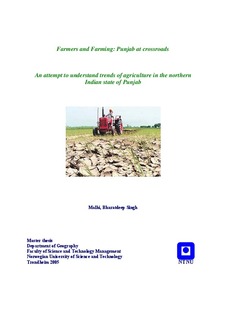| dc.contributor.advisor | Lein, Haakon | nb_NO |
| dc.contributor.author | Malhi, Bharat Deep Singh | nb_NO |
| dc.date.accessioned | 2014-12-19T14:24:52Z | |
| dc.date.available | 2014-12-19T14:24:52Z | |
| dc.date.created | 2005-12-19 | nb_NO |
| dc.date.issued | 2005 | nb_NO |
| dc.identifier | 125787 | nb_NO |
| dc.identifier.uri | http://hdl.handle.net/11250/265009 | |
| dc.description.abstract | Punjab, a modest-sized state tucked away on the north-western border of India, is often known as the bread basket of India. Huge grain surpluses produced by its farmers since the green revolution helped the country gain self-sufficiency in food. But there is growing perception in the sense of uncertainty regarding what the future holds for the state. After a spectacular growth rate during the sixties and the seventies, Punjab’s economy has decelerated during 1990’s. The state wonders whether the younger generation will grow in the most affluent and developed state in the country as their parents once did. Will the heady days of the ‘green revolution’ ever return to Punjab?
Such anxieties are not without reasons: there is stagnation in agriculture which is the most dominant factor in the states economy as the result Punjab, presently is one of the slowest growing Indian states. The agricultural practices in the state seem to be increasingly becoming environmentally unsustainable. The stellar growth of monocultural pattern of wheat and rice has resulted in manifestations of several adverse effects like groundwater exploitation, soil degradation. The stagnation in agriculture has also resulted in various socio-economic problems.
The primary reasons of stagnation were found to be over dominance of wheat and rice cropping system, over investment in agricultural machinery, over dependence on migrant labour besides some attitudinal changes in the behaviour of the farmers. The major agricultural institutions of the state seemed to be lacking in extension services and clear policies about agriculture. The farm size is decreasing, thus making agriculture non profitable for small farmers. Farmers are facing problems due to lack of infrastructure facilities in agricultural setup.
Agricultural diversification should be encouraged to reverse the trends. Government should encourage industrialization and investment in agro-processing industries. This study defines the present problem as the result of all the three participating actors in state’s agriculture; farmers, agricultural university and the government. The conviction of this study is that proper policies should be put in place to help farmers bail out of the present agricultural crises. If the coordination between these three is established, it can go a long way in turning Punjab’s uncertain future into promising outlook as once existed. | nb_NO |
| dc.language | eng | nb_NO |
| dc.publisher | Fakultet for samfunnsvitenskap og teknologiledelse | nb_NO |
| dc.subject | SOCIAL SCIENCES | en_GB |
| dc.subject | Master of Philosophy in Development Studies, specialising in Geography | en_GB |
| dc.subject | samhälle/juridik | en_GB |
| dc.title | Farmers and Farming: Punjab at Crossroads: An attempt to understand trends in agriculture in the northern Indiand state of Punjab | nb_NO |
| dc.type | Master thesis | nb_NO |
| dc.source.pagenumber | 133 | nb_NO |
| dc.contributor.department | Norges teknisk-naturvitenskapelige universitet, Fakultet for samfunnsvitenskap og teknologiledelse | nb_NO |
